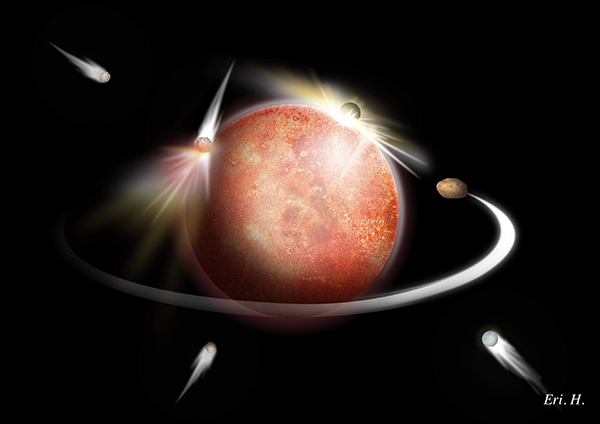Meteorite bombardments on Mars eject its surface materials into space, a part of which can be delivered to Martian moon Phobos. Using state-of-the-art numerical approaches, the research team reports that the amount of delivered materials is 10-100 times more than previously estimated. Before NASA and ESA complete the sample return mission from Mars, JAXA will get the Martian sample from its moon, and the whole history of Mars may be revealed from the Phobos samples.

Mars has experienced continuous asteroidal impacts throughout its history. These have produced impact-generated Mars ejecta, and a fraction of this debris is delivered to the moons of Mars: Phobos and Deimos (see Figure 1). The research team studied the amount and condition of recent delivery of impact ejecta from Mars to its moons. Using state-of-the-art numerical approaches, the team reports that the amount of delivered materials is 10-100 times more than previously estimated, and the delivered materials are physically and chemically different from the Martian meteorites, which are all igneous rocks with a limited range of ages. They show that Mars ejecta mixed in the regolith of its moons potentially covers all its geological eras and consists of all types of rocks, from sedimentary to igneous.
Phobos and Deimos, the two small moons of Mars, are the target bodies of the Japan Aerospace eXploration Agency (JAXA) sample return mission Martian Moons eXploration (MMX). The plan for MMX is to collect samples of more than 10 g of Phobos regolith. Assuming a typical cubic grain (a diameter of 0.3 mm and a density of 3 g/cm3), about 80 Martian grains would exist in the returned sample. These grains will provide a wealth of time-resolved geochemical information about the evolution of Martian surface environments.
| Journal | Scientific Reports |
| Tile of the paper | Transport of impact ejecta from Mars to its moons as a means to reveal Martian history |
| Authors | R. Hyodo(1)(2), K. Kurosawa(3), H. Genda(2), T. Usui(1), K. Fujita(1) |
| Authors | (1) ISAS, JAXA (2) Earth-Life Science Institute, Tokyo Institute of Technology (3) Planetary Exploration Research Center, Chiba Institute of Technology |
| DOI | 10.1038/s41598-019-56139-x |
| Online published date | 27 December 2019 |
